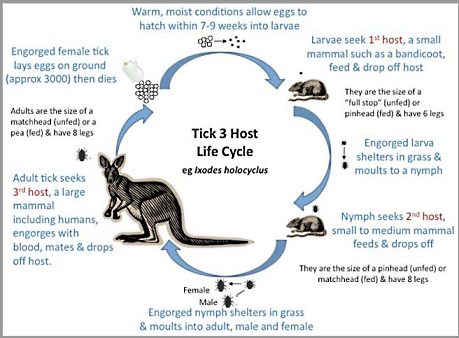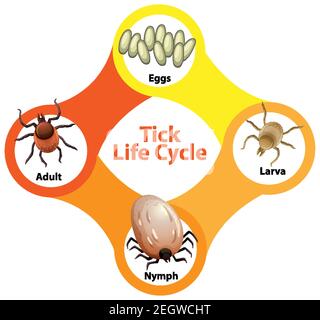Tick Life Cycle Australia
Ticks that require this many hosts can take up to 3 years to complete their full life cycle, and most will die because they don’t find a host for their next feeding. This means there could be many bush ticks present in the paddock and even on cattle (as tiny ‘seed’ ticks only about 1mm long) that are invisible to the producer.

Paralysis Ticks Three Things You Need To Know To Save Your Pets Life
Methods this study was carried out in two forest remnants in sydney, australia:

Tick life cycle australia. As the tick engorges on more human blood the tick paralysis symptoms may intensify including after the tick has been removed. Six stages, including a portion of skin with ticks in situ. All three tick families ticks have four lifecycle stages:
With increasing participation in outdoor activities such as wilderness hikes, more people and their dogs may find themselves exposed to ticks. Middle head (0.11 km 2) and north head (3.85 km ). The durable polished blocks make excellent permanent museum mounts, permitting viewing of the specimen from all sides.
After hatching from the eggs, ticks must eat blood at every stage to survive. The cattle tick life cycle is an average of 21 days. There are four stages in the life cycle of a tick;
Female cattle ticks feed on blood for 7 to 12 days. Pittwater study area 9 identifying ixodes holocyclus paralysis tick 10 tick anatomy 11 lyme disease 12 lyme disease in australia 12 what is lyme disease? After 3 different host feedings they then moult to the nymph stage which are about 1mm.
Larvae, nymphs and adults attach and feed on different hosts. Early symptoms of tick paralysis can include rashes, headache, fever, flu like symptoms, tenderness of lymph nodes, unsteady gait, intolerance to bright light, increased weakness of the limbs and partial facial paralysis. Life history cycle larvae or seed/grass ticks are tiny (0.5mm) and found mostly in autumn and winter.
Larvae, or ‘seed ticks’, hatch from eggs and swarm up grass blades, where they may survive for up to 6 months before finding a suitable host. The paralysis tick needs to feed on blood to develop through its lifecycle from the larvae stage to a nymph and to an adult. The parasitic stage of the life cycle involves 3 phases;
Egg, larva, nymph, and adult. Life cycle of cattle ticks there are four stages in the life cycle of the cattle tick: The engorged female ticks drop off the beast and lay their eggs, from which larvae hatch and travel up blades of grass.
Ornate kangaroo tick ( amblyomma triguttatum ) all female ticks need to take a blood meal before producing eggs. Most ticks go through four life stages: Thistick’s life cycle is comprised of four stages.
Cattle ticks undergo a moult on the host between the larval, nymph and adult phases. The entire life cycle of the paralysis tick, involving 4 stages and 3 hosts, will take around a year to complete. They can stay there for up to eight months before finding the right host walking by and brushing up against the grass.
All sizes and life stages of paralysis ticks can be found at any time of year, but there are distinct seasonal peaks for each stage. When they do attach themselves to a host, they feed for about a week, shed their skins (moult) and turn into nymphs. The life cycle of ixodes holocyclus consists of four stages:
The life cycle of australian ticks. It can take up to three years for a tick to complete its life cycle, but many die in process, seeking a host. This tick has been categorized as an invasive species in australia, new zealand, and several pacific islands (sleeman 2018).
Female adult ticks lay up to 3000 eggs in litter, of which x. Egg, larva, nymph and adult. The parasitic stage of the tick life cycle (the stage spent on an animal), is spent entirely on a single host.
Development in autumn and winter tiny australian paralysis tick larvae (‘seed’ or ‘grass’ ticks) cluster on, or close to the ground. Ixodes holocyclus requires three hosts to complete its life cycle; 9 observed seasonal occurrence of life cycle of ixodes holocyclus.
The two headlands are spatially independent, separated by ocean and urban development, and parts of both headlands are classified as sydney In australia, the most common paralysis tick is ixodes holocyclus, or the eastern australian paralysis tick, and it is the cause of tick paralysis in thousands of domestic animals each year,. A tick life cycle generally involves four stages:
Ticks

Hard Tick Life Cycle Us Tennessee Valley Authority Drawing Download Scientific Diagram
Dogs And Ticks - Living In Australia - Moving To Australia - Pomsinoz Forum

Life-cycle Of A Multi-host Argasid Tick Example Is Ornithodoros Download Scientific Diagram

1 Typical Three Host Life Cycle Of A Female Ixodid Hard Tick Download Scientific Diagram

The Lifecycle Of The Three-host Tick Ixodes Holocyclus 5 Download Scientific Diagram

Mittagong Veterinary Hospital Great Tails And Whats New Blog

Ticks And Tick Paralysis Vet-n-pet Help

Hang On A Tick Are Ticks Really The Vectors For Australian Trypanosomes Trends In Parasitology

Diagram Showing Life Cycle Of Tick Illustration Stock Vector Image Art - Alamy

Ixodes Holocyclus - Wikiwand
Nymph Ticks The Top 7 Facts You Need To Know - Tick Safe And The Mozzie Team

Life-cycle Of Ixodes Holocyclus Paralysis Tick In Relation To Season Download Scientific Diagram
2

An Overview Of Tick Paralysis - Symptoms Treatment And Prevention

Ticks And Prevention - Lyme Disease Association Of Australia

Tick-life-cycle - Tick Safe And The Mozzie Team

Ticks

Tick Paralysis In Cats - Clinical Signs Treatment Prognosis